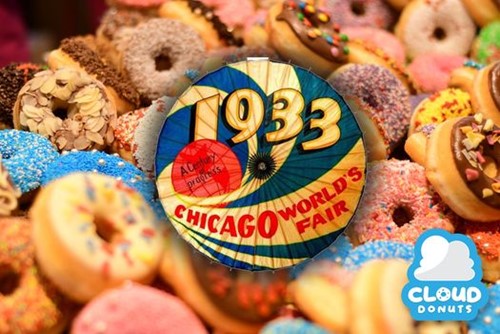Editor’s Staff
Motor Oil and Doughnuts
For a period of time that included most of the 1930s the Chicago Daily Tribune ran a daily array of news-photos on their back page. On Saturday, June 17, 1933, it was Page 34. When it became a regular feature would not be impossible to learn, but it is not germane to this story.
That day there were twelve photographs. Those who worked in the front-office referred to the page as the “array of the day,” and frequently spent large sums to be first-on-the-street with an action photo of an event. Five of the twelve photos were of a crime scene, the victim of a robbery, the two criminals, and the police officers who handled those incidents. There was a portrait of a retiring priest, a picture of the mayor welcoming a guest of honor to Chicago, a wirephoto of a fire in Wichita, Kansas, and two pictures of the 1933 Century of Progress World’s Fair.

One of the two pictures of the World’s Fair was the Havoline Thermometer tower. It was dedicated the day before. The item that announced the dedication appeared on Page 8:
The Havoline thermometer at 23d street was dedicated yesterday afternoon with C. A. Donnel, senior meteorologist in Chicago as honored guest. Mr. Donnel compared the neon lighted tube with an official thermometer and pronounced it accurate. President Rufus C. Dawes made a short address on behalf of the Fair.
There were two official postcards of the Havoline Thermometer; one copyrighted 1933 by the Indian Refining Company (from whom there were at least five variations), the other was from the American Colortype Company of Chicago and New York. Needless to say, there are likely dozens, if not hundreds of real-photo cards with individuals, couples, or families aligned at the base for “proof-of-presence” evidence.
The differences in the variations are interesting. Some have people; some do not. Others have trees, or not. The one commonality is that each image shows the thermometer at 75 degrees.
The primary source materials tell the story as follows:
The Havoline Thermometer
Just north of the Twenty-third Street entrance, a great 200-foot tower rises. By day and by night it can be seen from many sections of the Fair and the great numerals on its three faces can be read easily. It is a thermometer, perhaps the largest the world has ever seen, and it accurately tells A Century of Progress visitor the temperature in Chicago.
The numerals are ten feet high, and the graduated temperature columns are made of neon tubing, electrically regulated by a master thermometer. Its official name is the Havoline Thermometer, but officials of the Indian Refining Company dedicated it as a “Monument to Chicago’s Climate.” Ten miles of wire, 3,000 feet of neon tubing, and 60 tons of steel were required for the structure. In a building at the base of the tower the company presents an exhibit of oil refining equipment and products. Here you see what keeps your motor running smoothly, and why.

The Havemeyer Oil Company of New York first introduced the Havoline brand in 1904. In 1906 the Havoline Oil Company separated from the Havemeyer Oil Company. The Indian Refining Company bought the name and logo in May 1909 and remarkable success followed because of coast-to-coast advertising and sales representative campaigns. In 1915 due to overproduction the operation stopped but resumed in the 1930s, when it again changed owners and the Texas Oil company (now Texaco) bought the entire Indian Refining Company.
“A Century of Progress International Exposition” was the official title of the 1933 World’s Fair in Chicago. It was intended to celebrate Chicago’s one hundred year anniversary. The objective of the fair was to demonstrate scientific and technological discoveries to industry and modern society and to show how those discoveries were being made, and who was making them.
Also on exhibit were the enormous achievements made during the most recently past decades in the worlds of architecture, arts, entertainment, and literature. From around the globe exhibits included new automobile designs and houses of the future. There was also an abundance of carnival entertainment that included a skyride which was a cable-suspended people mover that was higher than any building in Chicago.
The midway provided games and a roller coaster for the children, shows of every genre for the curious, and foods from around the world.
The Adolph Levitt Doughnut Machine
In one of those aforementioned decades a man named Adolph Levitt invented a machine that made doughnuts at a rate of dozens per hour. The process was simple, the machine was designed to have a dough ring slide along a channel overflowing with boiling oil that “cooked” the dough. At the end of the run, the doughnut would fall into a collection basket, ready for icing, powder sugaring, or glazing.
Mr. Levitt’s doughnut machine made its public debut at the Fair. The doughnuts it made were not just a carnival-fad, they were being proclaimed as the “Hit Food of the Century of Progress,” lauded as the perfect union of fresh ingredients and automated preparation. A delicacy that would become “a staple of the working class” during the Depression that followed.

From motor oil to doughnuts! Isn’t this a simply perfect world?
Chicago had great fairs. After reading this I want to have my motor oil changed after visiting local donut shop.
I wonder if Adolph Levitt was the inspiration for children’s book title character Homer Price’s Uncle Ulysses, whose lunchroom’s doughnut machine get out of control when a “helpful” customer tried to show Homer her family’s recipe but put too much batter in the machine.
I have a few cards from this exhibition.
Once again, another bit of sunshine on a dark planet! It seems this organization always delivers with fascinating stories that light me up. This is another great one!